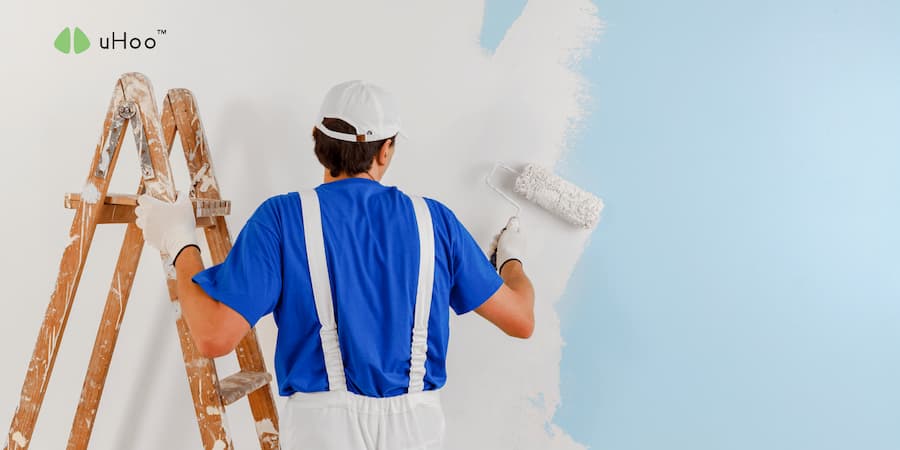Painting is a fantastic way to refresh a space and express creativity, but it’s crucial to be aware of the potential hazards associated with the process. The risks can sometimes overshadow the rewards, from toxic fumes to harmful chemicals.
Whether you’re a DIY enthusiast or a seasoned pro, understanding these hazards and how to mitigate them will help you create a beautiful environment without compromising your health.
In this guide, we’ll explore safe paint options and practical tips for eliminating harmful fumes, ensuring your painting project is as secure as it is satisfying.
Why Are Paints Hazardous for Our Respiratory Health?
Paints, while essential for beautifying and protecting surfaces, can pose significant risks to our respiratory health. Understanding these risks requires a closer look at volatile organic compounds (VOCs) often found in traditional paint products.
Volatile organic compounds, or VOCs, are organic chemicals that evaporate quickly into the air at room temperature. According to the Environmental Protection Agency (EPA), VOCs are “organic chemical compounds whose composition makes it possible for them to evaporate under normal indoor atmospheric conditions.” This evaporation process, known as “off-gassing,” is not just a brief phenomenon. VOCs can continue to be released into the air for years after applying paint.
Common paint VOCs include formaldehyde, d-limonene, toluene, acetone, and ethanol. These chemicals can be found in paint and other household products like building supplies and new furniture.
These compounds can cause many immediate health issues, such as headaches, dizziness, and respiratory problems. Prolonged exposure can lead to more severe health concerns, including chronic respiratory conditions and other long-term effects.
One of the most alarming aspects of VOCs is that their presence is not limited to the time during and immediately after painting. Even after the “new paint” smell fades, VOCs continue to off-gas, potentially affecting indoor air quality for years. According to the EPA, indoor levels of VOCs can be up to two to five times higher than outdoor levels, further amplifying the risk.
What kind of paints are safe?
In recent years, heightened environmental awareness and stricter regulations have driven the evolution of safer, more eco-friendly paint options. If you’re considering a painting project, it’s crucial to understand the difference between various types of paints and their impact on your health and the environment.
Low-VOC and Zero-VOC Paints
Low-VOC Paints
These paints contain fewer volatile organic compounds (VOCs) than traditional paints, making them less harmful. However, they still have some VOCs, albeit at reduced levels. This makes them a better choice for improving indoor air quality while offering durability and cost-effectiveness.
Zero-VOC Paints
True to their name, zero-VOC paints contain negligible or no VOCs. This makes them an excellent option for those who prioritize air quality and are particularly sensitive to chemical exposures. These paints are formulated to be virtually free of harmful emissions, providing a safer indoor environment.
Key Differences Between Low-VOC and Zero-VOC Paint
While low-VOC paints are widely available and offer reduced harmful chemicals, they might still release some fumes. Zero-VOC paints, however, avoid adding VOC chemicals in their formulation, resulting in minimal emissions—sometimes trace amounts, if any.
When selecting a paint, look for products that meet the zero-VOC standard, defined as containing 5 grams per liter (g/L) or less of VOCs. Additionally, ensure that the brand does not use VOCs in tinting, as colorants can sometimes introduce VOCs into the mix.
Tips for Choosing Safe Paints
Choosing the right product can be confusing, especially with many eco-labels and non-toxic paint-call claims. To ensure you’re making a safe choice:
- Look for Eco-Labels: Verify that any eco-label certifications are backed by emissions tests approved by the Environmental Protection Agency (EPA). Labels such as Greenguard provide trustworthy indications of low VOC emissions.
- Check for Greenguard Certification: Greenguard Gold Certification is particularly rigorous. It indicates that the product has been tested for VOC emissions and meets strict safety standards. The Greenguard website can also help you find other eco-friendly products.
- Inspect Tinting Process: Confirm that zero-VOC paints do not include VOCs in their tinting process. Some colorants can introduce VOCs, even if the base paint is free.
How to get rid of paint fumes?
Keep the Room Well Ventilated
Enhancing ventilation is one of the easiest and most effective ways to reduce paint fumes. Open all windows and doors to allow fresh air to circulate and push out the stale, painted air. Fans can help increase airflow, while air purifiers can improve air quality by removing airborne particles. This method is crucial for expediting the dissipation of paint odors.
Maintain a Cool Indoor Temperature
Paint fumes tend to be more potent in warmer conditions. To mitigate this, keep your room cool after painting. Lower temperatures can reduce the intensity of the smell. Turn on your air conditioner or open windows for a cool breeze. A cooler environment will help dissipate the fumes more quickly.
Opt for Activated Charcoal
Activated charcoal may be more effective than baking soda if the paint smells powerful. Activated charcoal is known for its superior odor-absorbing properties. Place containers of activated charcoal around the room to capture and eliminate paint fumes more efficiently.
Utilize an Air Purifier
An air purifier can be valuable in removing paint odors and improving air quality. Choose a purifier with a HEPA filter to capture small particles and contaminants. Running the air purifier overnight can help clear out paint fumes and other airborne pollutants, making your space more pleasant and breathable.
Final Thoughts
While painting can revitalize and beautify your space, being mindful of potential hazards and taking appropriate precautions is essential for a safe and pleasant experience. By selecting low-VOC or zero-VOC paints and employing effective methods to eliminate paint fumes, you can protect your health and create a more enjoyable environment. Prioritizing these practices ensures that your painting project enhances your home’s appeal without compromising your well-being. With the right choices and strategies, you can achieve aesthetic satisfaction and a healthier living space.

